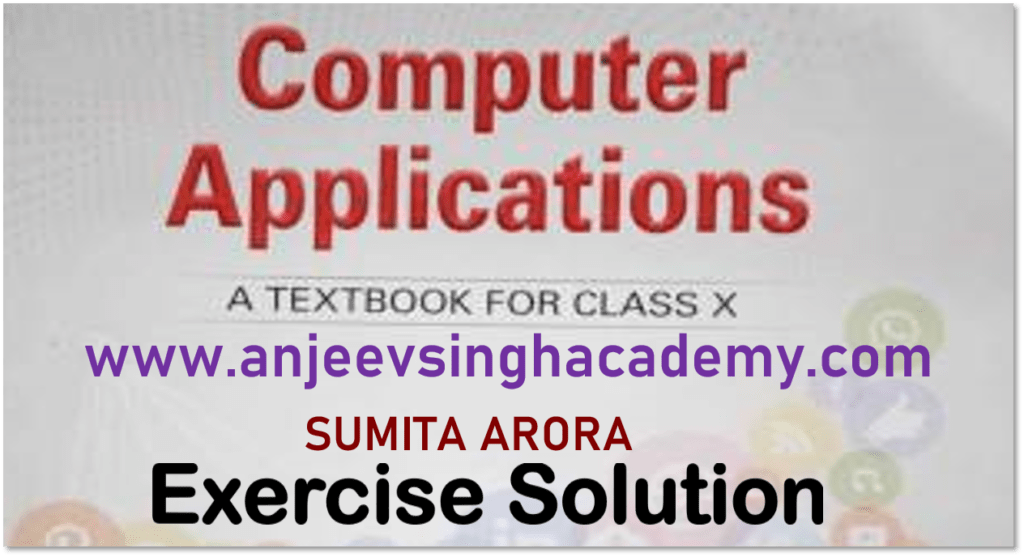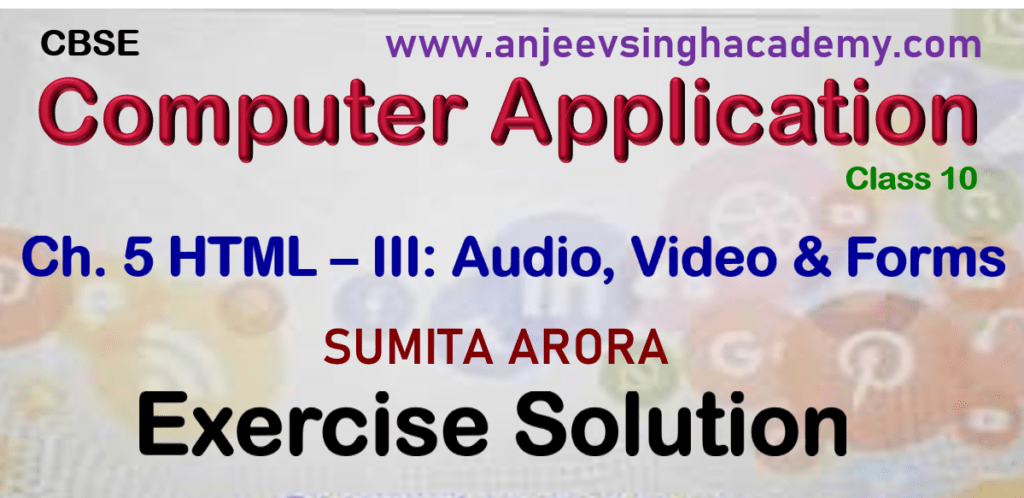Class 10 Computer Application code 165 Question Answer
Chapter 7: Cyberethics
Sumita Arora Book Exercise Question Answer Solution
Type A: Theoretical Questions
Que 1. What do you understand by the privacy of data in the e-commerce context?
Answer: Privacy is the protection of personal information given online. In e-commerce especially, it is related to a company’s policies on the use of user data.
Que 2. What role does consumer consent play in implementing the privacy of user data?
Answer: User consent play a vital role in implementing the privacy of user data. User consent decides what information can and cannot be used.
Que 3. What is the responsibility of an e-commerce merchant to ensure before getting the user’s consent about his/her details usage?
Answer: The e-commerce merchant must respect the privacy of user data. Before getting the consent, the merchant must clearly state about how the user data will be used in the terms and conditions of its site and implement technical safeguards for the safety of data provided by the user.
Que 4. What is online fraud? Give some examples.
Answer: Fraud committed using the internet is called Online fraud.
For example- Non-delivered goods, Stealing information, Fraudulent payment, stealing financial information, identity theft, etc.
Que 5. What is credit card fraud?
Answer: In credit card fraud, the credit card details of a user are stolen from his/her online activities, and then some payment frauds are carried out with this stolen information.
Que 6. What is identity theft?
Answer: In identity theft, the online identity of someone is stolen (like social media handles, email IDs, etc,) and fraudulent posts are posted or some other malicious/dangerous activity is carried out.
Que 7. What measures can you take to curb online fraud?
Answer: The measures to stop these frauds may include:
- A monitoring official body that ensures the sanctity of E-commerce companies and the delivery of goods/services as promised.
- Strong security mechanisms by the e-commerce site and payment gateways to prevent the stealing of crucial information.
- Official guidelines and safeguards on the selling of user’s data to third parties.
Que 8. What is safe data transmission? How can you ensure secure data transmission?
Answer: Secure/Safe data transmission means applying enough technical safeguards so that data travels safely to its target, without being compromised or eavesdropped.
To ensure secure data transmission, the following techniques are applied:
- Use of Secure Socket Layer.
- Use of Data Encryption technique.
- Use of Safe protocols, such as secure FTP, Secure Shells (SSH), etc.
Que 9. What is intellectual property? What do you understand by intellectual property rights?
Answer: Intellectual property is a category of property that includes intangible creations of the human intellect.
Intellectual property rights are the rights of the owner of the information to decide how much information is to be exchanged, shared, or distributed. It gives the owner a right to decide the price of exchanging, sharing, and distributing.
Que 10. What is plagiarism? How can you avoid plagiarism while referring to someone’s else creation?
Answer: Plagiarism is stealing someone else’s intellectual work and representing it as your own work without citing the source of information.
We can avoid plagiarism by giving credit by citing and giving references to the original author/creator.
Que 11. What is digital property? What are the threats to digital properties?
Answer: Digital property refers to any information about you or created by you that exists in digital form, either online or on an electronic storage device.
Que 12. How can you protect your digital properties?
Answer: Digital property rights can be protected by
- By using the anti-temper solution, the digital property can be protected.
- By adding the legal clause.
- By sharing the software code to trusted individuals.
Que 13. Expand the terms: OSI, FLOSS, FSF, GNU, GPL, W3C, OSS.
Answer: Full forms of the given terms are: –
- OSI: Open Source Initiative
- FLOSS: Free Libre Open Source Software
- FSF: Free Software Foundation
- GNU: GNU Not Unix
- GPL: General Public License
- W3C: World Wide Web Consortium
- OSS: Open Source Software
Que 14. What is open-source-based software?
Answer: The software whose source code is available freely and which can be used free of cost, called open source-based software.
Que 15. Compare and contrast: (i) Free software and Open source software (ii) OSS and FLOSS (iii) Proprietary software and Free Software (iv) Freeware and Shareware (v) Freeware and Free Software
Answer: (i) Free Software and Open Source Software
Free Software means the software is freely accessible and can be freely used, changed, improved, copied, and distributed by all who wish to do so.
Open Source Software can be freely used but it does not have to be free of charge. Open-source software may receive payments concerning support and further business development.
(ii) OSS and FLOSS
OSS: OSS refers to open source software, which refers to software whose source code is available to customers and can be modified and redistributed without any limitation.
FLOSS: FLOSS refers to Free Libre and Open Source Software or to Free Livre and Open Source Software. The term FLOSS is used to refer to software which is both free software as well as open source software.
(iii) Proprietary Software and Free Software
Proprietary Software is the software that is neither open nor freely available. Its use is regulated and further distribution and modification is either forbidden or requires special permission by the supplier or vendor. The source code of proprietary software is normally not available.
Free Software means the software is freely accessible and can be freely used, changed, improved, copied, and distributed by all who wish to do so.
(iv) Freeware and Shareware:
(v) Freeware and Free Software:
Que 16. What is public domain software?
Answer: Public-domain software is free and can be used without restrictions. Public domain software is used to include freeware, free software that is nevertheless copyrighted.
Que 17. Name some common public domain software licenses.
Answer: Some common public domain software licenses are GPL, LGPL, MIT License, Apache License, BSD License, etc.
Que 18. What is GPL software license? How is it different from LGPL software license?
Answer: The GNU General Public Licence (GPL) is probably one of the most commonly used licenses for open-source projects. The GPL grants and guarantees a wide range of rights to developers who work on open-source projects.
The GNU Lesser General Public License (LGPL) offers lesser rights to a work than the standard GPL license. The LGPL is used to license free software so that it can be incorporated into both free software and proprietary software.
The LGPL and GPL licenses differ with one major exception; with LGPL the requirement that you have to release software extensions in open GPL has been removed.
Que 19. What is freedom of information?
Answer: Freedom of Information refers to the right to access information available on public platforms.
Que 20. What are the major factors behind the digital divide?
Answer: A digital divide is an economic and social inequality about access to, use of, or impact of information and communication technologies (ICT).
Que 21. Write any one application each of e-Governance and e-Commerce.
Answer: Applications of e-governance and e-commerce:
E-governance
- Online service delivery, such as filing taxes, applying for permits, and accessing government records.
- Involving citizens in the decision-making process and promoting transparency and accountability.
- Providing information and services faster, cheaper, and to wider groups of customers.
E-commerce
- Online shopping.
- Online banking.
- Online travel booking.







